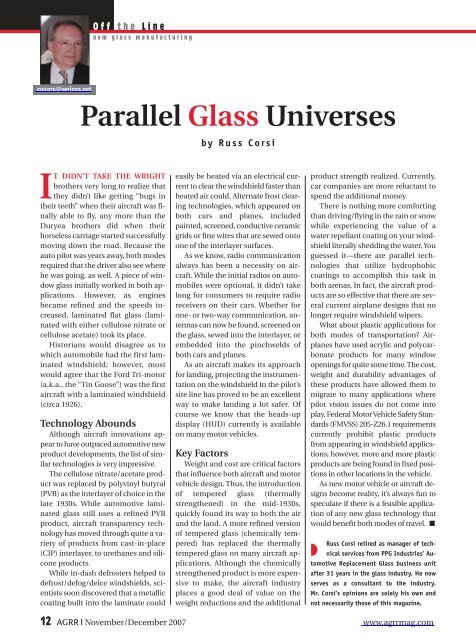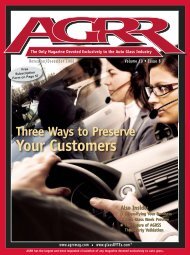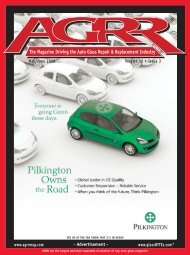AGRR - November/December 2007 - AGRR Magazine
AGRR - November/December 2007 - AGRR Magazine
AGRR - November/December 2007 - AGRR Magazine
You also want an ePaper? Increase the reach of your titles
YUMPU automatically turns print PDFs into web optimized ePapers that Google loves.
Off theLineoem glass manufacturingrsscors@verizon.netParallel Glass Universesby Russ CorsiIT DIDN’T TAKE THE WRIGHTbrothers very long to realize thatthey didn’t like getting “bugs intheir teeth” when their aircraft was finallyable to fly, any more than theDuryea brothers did when theirhorseless carriage started successfullymoving down the road. Because theauto pilot was years away, both modesrequired that the driver also see wherehe was going, as well. A piece of windowglass initially worked in both applications.However, as enginesbecame refined and the speeds increased,laminated flat glass (laminatedwith either cellulose nitrate orcellulose acetate) took its place.Historians would disagree as towhich automobile had the first laminatedwindshield; however, mostwould agree that the Ford Tri-motor(a.k.a., the “Tin Goose”) was the firstaircraft with a laminated windshield(circa 1926).Technology AboundsAlthough aircraft innovations appearto have outpaced automotive newproduct developments, the list of similartechnologies is very impressive.The cellulose nitrate/acetate productwas replaced by polyvinyl butyral(PVB) as the interlayer of choice in thelate 1930s. While automotive laminatedglass still uses a refined PVBproduct, aircraft transparency technologyhas moved through quite a varietyof products from cast-in-place(CIP) interlayer, to urethanes and siliconeproducts.While in-dash defrosters helped todefrost/defog/deice windshields, scientistssoon discovered that a metalliccoating built into the laminate couldeasily be heated via an electrical currentto clear the windshield faster thanheated air could. Alternate frost clearingtechnologies, which appeared onboth cars and planes, includedpainted, screened, conductive ceramicgrids or fine wires that are sewed ontoone of the interlayer surfaces.As we know, radio communicationalways has been a necessity on aircraft.While the initial radios on automobileswere optional, it didn’t takelong for consumers to require radioreceivers on their cars. Whether forone- or two-way communication, antennascan now be found, screened onthe glass, sewed into the interlayer, orembedded into the pinchwelds ofboth cars and planes.As an aircraft makes its approachfor landing, projecting the instrumentationon the windshield in the pilot’ssite line has proved to be an excellentway to make landing a lot safer. Ofcourse we know that the heads-updisplay (HUD) currently is availableon many motor vehicles.Key FactorsWeight and cost are critical factorsthat influence both aircraft and motorvehicle design. Thus, the introductionof tempered glass (thermallystrengthened) in the mid-1930s,quickly found its way to both the airand the land. A more refined versionof tempered glass (chemically tempered)has replaced the thermallytempered glass on many aircraft applications.Although the chemicallystrengthened product is more expensiveto make, the aircraft industryplaces a good deal of value on theweight reductions and the additionalproduct strength realized. Currently,car companies are more reluctant tospend the additional money.There is nothing more comfortingthan driving/flying in the rain or snowwhile experiencing the value of awater repellant coating on your windshieldliterally shedding the water. Youguessed it—there are parallel technologiesthat utilize hydrophobiccoatings to accomplish this task inboth arenas. In fact, the aircraft productsare so effective that there are severalcurrent airplane designs that nolonger require windshield wipers.What about plastic applications forboth modes of transportation? Airplaneshave used acrylic and polycarbonateproducts for many windowopenings for quite some time. The cost,weight and durability advantages ofthese products have allowed them tomigrate to many applications wherepilot vision issues do not come intoplay. Federal Motor Vehicle Safety Standards(FMVSS) 205-Z26.1 requirementscurrently prohibit plastic productsfrom appearing in windshield applications;however, more and more plasticproducts are being found in fixed positionsin other locations in the vehicle.As new motor vehicle or aircraft designsbecome reality, it’s always fun tospeculate if there is a feasible applicationof any new glass technology thatwould benefit both modes of travel. ■◗Russ Corsi retired as manager of technicalservices from PPG Industries’ AutomotiveReplacement Glass business unitafter 31 years in the glass industry. He nowserves as a consultant to the industry.Mr. Corsi’s opinions are solely his own andnot necessarily those of this magazine.12 <strong>AGRR</strong> <strong>November</strong>/<strong>December</strong> <strong>2007</strong> www.agrrmag.com





